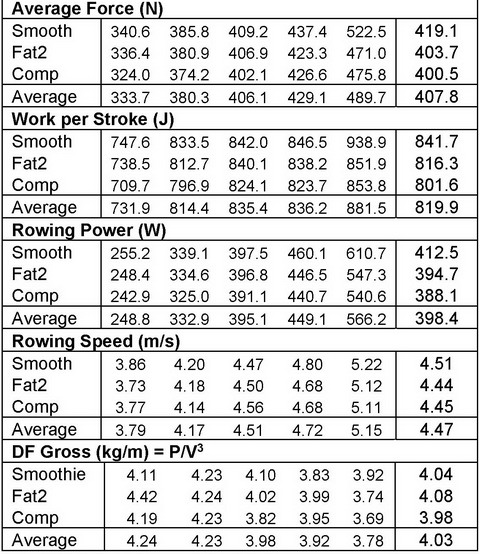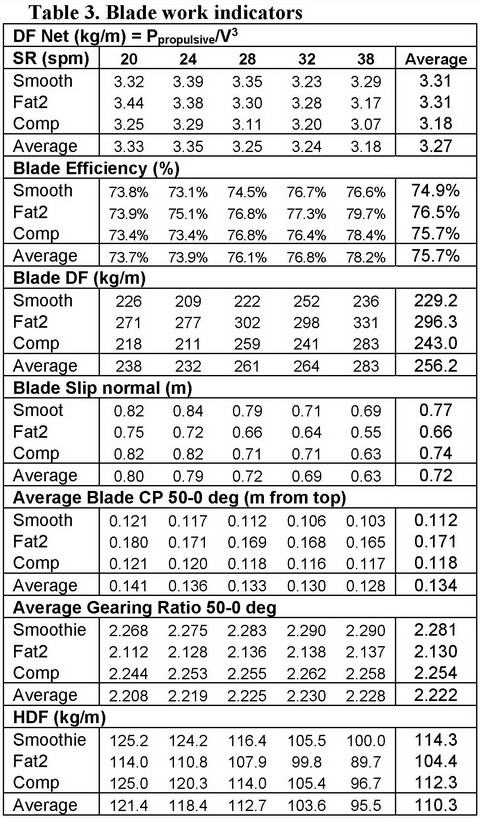Comparison of different blade types
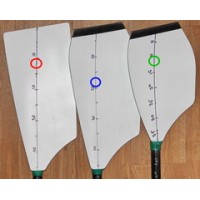
The new measurement method of the blade centre of pressure, developed earlier (RBN 2020/10), was used for the comparison of various blade types made by Concept2: Smoothies (plain, 88/288), Fat2 (vortex 88/282) and the new Comps (vortex, 88/288). Three pairs of sculls with these blade types (Fig.1) were instrumented with four force torque sensors each as described before. It was originally planned to test the blades simultaneously with three single scullers, but due to illness, only one became available (1.84m, 85kg, international U23 level), who completed three 1000m runs with step-increasing stroke rate (20, 24, 28, 32, 38spm) changing the sculls after each run.
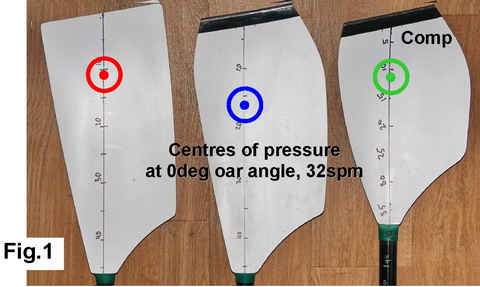
|
|
The testing was well completed in acceptable weather conditions (mild wind, rain): the stroke rates (Table 1 in the Appendix) and force curves (Fig.2, a) were nearly identical with all three blade types. Rowing power, speed and other main rowing indicators were also quite similar (Tab.2,3) with slightly higher power and speed during the first run with Smoothies.
Blade work was similar for Smoothies and Comps, and slightly shallower with Fat2 (Fig.2,b). This could be related to the feedback from the sculler that “Fat2 were the most uncomfortable blades to row, creating problems with the pitch and keeping the blade in the water”.
The Centre of Pressure (CP) on the blade was similar with Smooth and Comps at 11-12cm from the blade top, but was located further in with the Fat2 – at 17-18cm (Fig.1, 2,d, Tab.3). The measured Centre of Force (CF) at the handle was located for the same 8cm from the handle top in all oars. In combination with the shorter outboard of Fat2 (1.94m compared to 2.00m for Smooth and Comps), this leads to much lighter actual gearing ratio 2.13 (actual outboard/inboard) for Fat2 compared to 2.28 for Smooth and 2.25 for Comps (Fig.2,e, Tab.3). This finding was confirmed with HDF analysis, which was found lighter for Fat2 (104) compared to Smooth (114) and Comps (112). This means Fat2 blade does not require shorter outboard and blade length as thought before. Due to the more inner location of the CP at the blade, Fat2 should be rigged using a similar outboard to the other blade types. It is interesting that actual gearing based on CP was significantly (7-8%) heavier than the previously used gearing ratio based on geometrical centre of the blade.
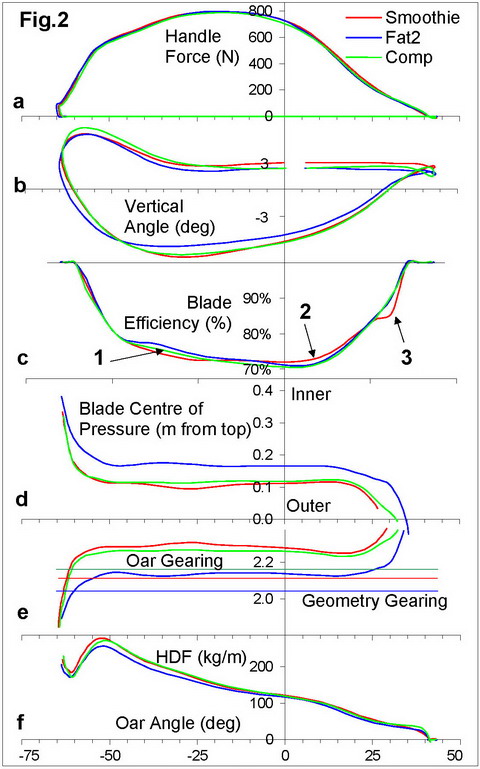
Now to address the most interesting question: which blade is the most efficient and provides minimal energy losses due to slippage, and the highest rowing speed? Unfortunately, the inability to test the blades simultaneously and thus eliminate the effect of random weather conditions does not allow us to make a definite conclusion. However, using the blade efficiency analysis based on boat and oar measurements (RBN 2018/05-7), it is possible to estimate blade qualities. The Fat2 blade showed the highest average blade efficiency (76.5%) compared to the Comps (75.7%) and Smoothies (74.9%). Fat2 were more efficient during the first half of the drive (Fig.2,c,1), while Smoothies were better “after the pin” (2), but with a strange “glitch” before the finish (3). The efficiency was confirmed with the blade Drag Factor DF values: it was the highest for Fat2 (296 kg/m), lower for Comps (243) and the lowest for Smoothies (229). The slip in the normal to the blade axis direction was also the shortest in Fat2 (0.66m) compared to the Comps (0.74m) and Smoothies (0.77m).
Fig.3 below illustrates the above data with graphical presentation of the trajectory of the blade CP during the drive. The curves were synchronized at the starting point in the X direction (towards the boat velocity), but Fat2 had a lower Y coordinate because of the shorter actual outboard. At the final point of the dive, the CP of Fat2 was about 0.2m ahead of Smooth and Comps.
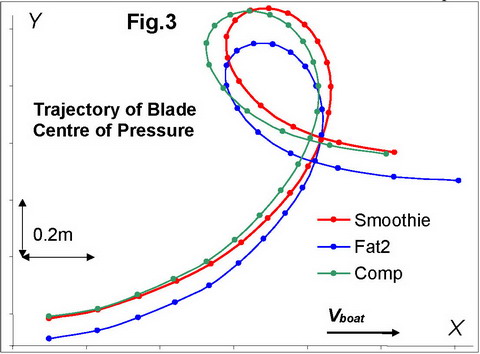
Concluding, based on the limited data available, it looks like the Fat2 blade was the most efficient between the three types tested. The new Comp blade type showed a slightly better performance compared to the traditional Smoothies and were quite comfortable to row. These preliminary findings require further experiments and analysis to eliminate the random effect of the weather. Also, the effect of the Vortex strips should be studied. Though Fat2 blades appeared to be the most efficient, they were qualitatively the most uncomfortable to row, so more work could be done on the blade shape improvement.
Acknowledgements: Thanks to Concept2 Inc. and personally to Dick Dreissigacker for the interest and kind support of this study.
©2020 Dr. Valery Kleshnev www.biorow.com
Appendix 1.

